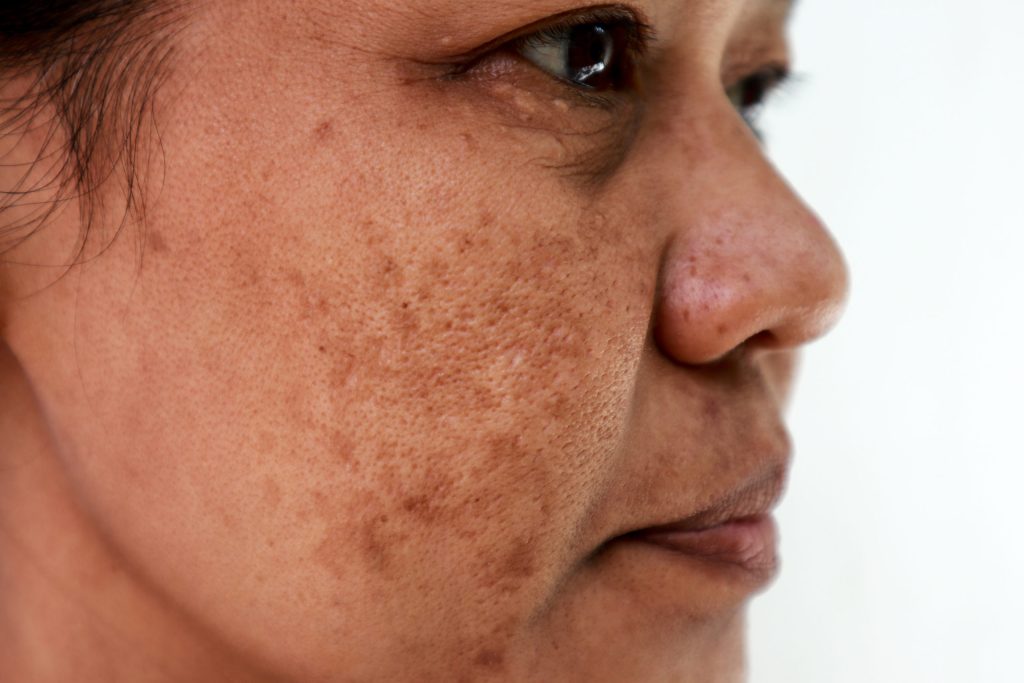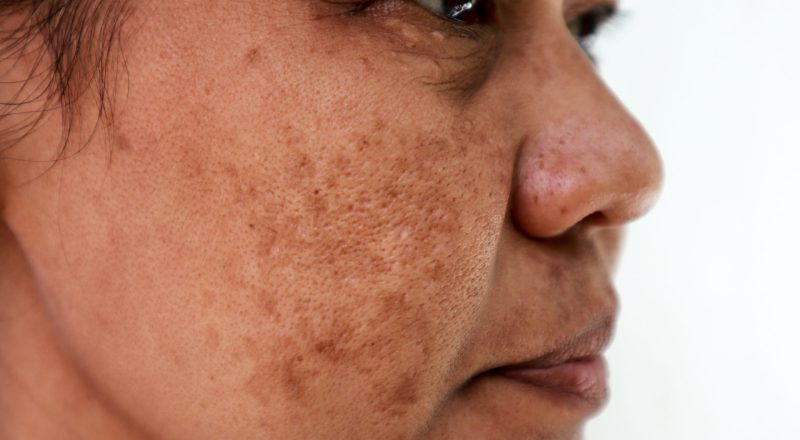Introduction
Melasma also called the “mask of pregnancy,” is a common skin condition characterized by the development of dark, discolored patches on the face. While it is not a serious medical condition, melasma can have a significant impact on a person’s self-esteem and confidence. In this blog, we will delve into what melasma is, explore its causes and symptoms, and discuss various treatment options available to manage and alleviate this skin concern.
Melasma is a dermatological condition that primarily affects the skin on the face, although it can occur in other sun-exposed areas of the body. It is more prevalent in women, particularly those with darker skin tones, and often becomes noticeable during pregnancy or as a result of hormonal fluctuations. Melasma is not contagious, nor is it related to personal hygiene.
Causes of Melasma

The precise cause of melasma is not fully understood or found yet, but several contributing factors have been identified:
- Hormonal Changes: Hormonal fluctuations during pregnancy, menopause, or while taking birth control pills are known to trigger melasma. These hormonal changes can stimulate the production of melanin, the pigment responsible for skin color.
- Sun Exposure: Exposure to ultraviolet (UV) rays from the sun or any other artificial sources like tanning beds can exacerbate melasma. UV rays can stimulate melanocytes, the cells responsible for producing melanin, leading to increased pigmentation in affected areas.
- Genetics: A family history of melasma can increase an individual’s susceptibility to developing the condition. Genetics also plays a role in determining how the skin responds to various triggers.
- Hormone-Based Medications: Certain medications, like hormone replacement therapy or birth control pills, can contribute to melasma in some individuals. This is because these medications can alter hormonal balance.
- Skin Irritation: Skin care products or treatments that irritate the skin can worsen melasma. Harsh chemical peels, for instance, may trigger increased pigmentation in affected areas.
Symptoms of Melasma
Melasma typically presents as brown or grayish-brown patches on the face, particularly on the forehead, nose, cheeks, and upper lip. These patches often have a symmetrical pattern, meaning they appear on both sides of the face in a similar distribution. While melasma is primarily a cosmetic concern, it does not cause any pain.
The severity of melasma can vary from person to person, and it is categorized into three main types:
- Epidermal Melasma: This type of melasma affects the top layer of the skin (epidermis) and results in light to dark brown patches.
- Dermal Melasma: Dermal melasma occurs deeper in the skin’s dermal layer and is characterized by bluish-gray patches that may be more challenging to treat.
- Mixed Melasma: As the name suggests, mixed melasma combines characteristics of both epidermal and dermal melasma, resulting in a mix of brown and bluish-gray patches.
Treatment Options for Melasma
While there is no definitive cure for melasma, several treatment options are available to manage and improve its appearance. The efficacy of these treatments can vary depending on the type and severity of melasma, as well as individual factors. It’s essential to consult a dermatologist for a personalized treatment plan. Here are some common treatment options:
1. Sun Protection: One of the most critical aspects of melasma management is sun protection. Wearing broad-spectrum sunscreen with SPF 30 or higher, along with protective clothing and hats, can help prevent further pigmentation and protect the skin from UV damage.
2. Topical Treatments: Dermatologists may prescribe topical treatments containing ingredients like hydroquinone, tretinoin, corticosteroids, or a combination of these. These products work to lighten and even out the skin tone. However, these treatments should be used under the supervision of a dermatologist to avoid potential side effects.
3. Chemical Peels: It involve the use of a chemical to the skin, which causes the top layer to peel off, revealing fresher, less pigmented skin underneath. Chemical peels can be effective for epidermal melasma but may require multiple sessions.
4. Microdermabrasion: It is a non-invasive treatment that exfoliates the top layer of skin using a machine with tiny crystals or a diamond-tipped wand. It can help improve the appearance of melasma by stimulating collagen production and skin rejuvenation.
5. Laser Therapy: Various laser and light-based treatments, such as fractional laser and intense pulsed light (IPL), can target melasma by breaking down excess pigment. These treatments are more effective for dermal and mixed melasma but may carry some risks and require downtime.
6. Oral Medications: In some cases, dermatologists may prescribe oral medications like tranexamic acid or certain antioxidants to help manage melasma from within. These treatments are typically used in combination with topical therapies.
7. Cosmetics: Makeup and concealing products specifically designed to cover pigmented areas can help individuals with melasma achieve a more even skin tone temporarily.
Conclusion
Melasma is one of the common skin conditions that affects many individuals, particularly women with darker skin tones. While it is not a serious medical condition, its impact on self-esteem and appearance can be significant.
If you or someone you know is struggling with melasma, it is advisable to consult a dermatologist for a personalized treatment plan. Sun protection, topical treatments, and various procedures like chemical peels and laser therapy are among the options available to manage and improve the appearance of melasma. With proper care and guidance, individuals with melasma can achieve a more radiant complexion, helping to restore their confidence and self-image.
